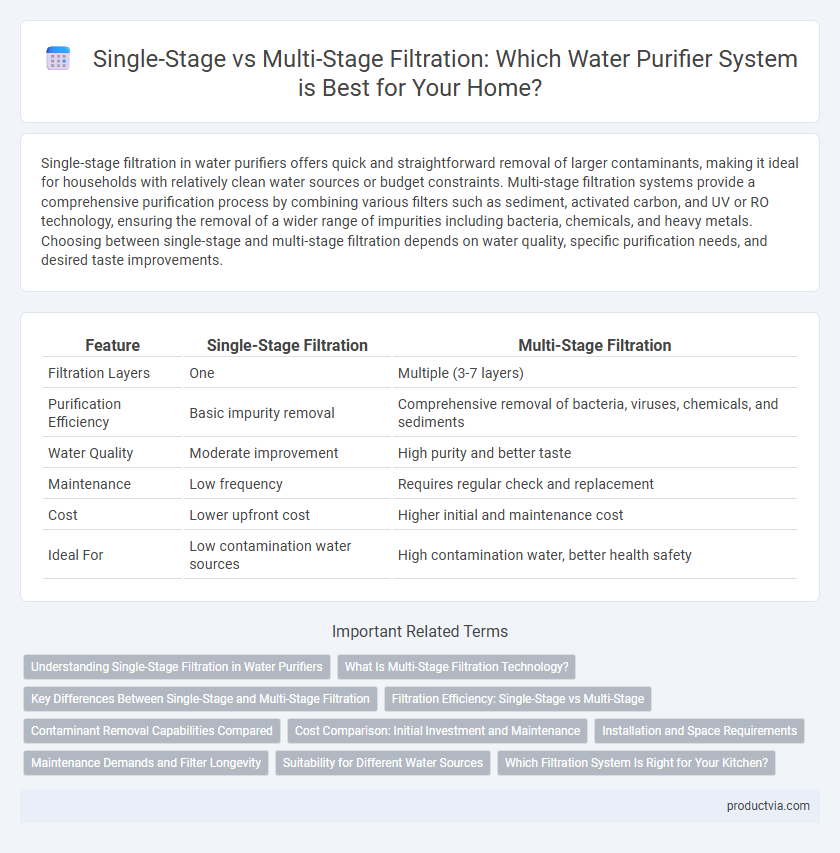Single-stage filtration in water purifiers offers quick and straightforward removal of larger contaminants, making it ideal for households with relatively clean water sources or budget constraints. Multi-stage filtration systems provide a comprehensive purification process by combining various filters such as sediment, activated carbon, and UV or RO technology, ensuring the removal of a wider range of impurities including bacteria, chemicals, and heavy metals. Choosing between single-stage and multi-stage filtration depends on water quality, specific purification needs, and desired taste improvements.
Table of Comparison
| Feature | Single-Stage Filtration | Multi-Stage Filtration |
|---|---|---|
| Filtration Layers | One | Multiple (3-7 layers) |
| Purification Efficiency | Basic impurity removal | Comprehensive removal of bacteria, viruses, chemicals, and sediments |
| Water Quality | Moderate improvement | High purity and better taste |
| Maintenance | Low frequency | Requires regular check and replacement |
| Cost | Lower upfront cost | Higher initial and maintenance cost |
| Ideal For | Low contamination water sources | High contamination water, better health safety |
Understanding Single-Stage Filtration in Water Purifiers
Single-stage filtration in water purifiers typically involves one primary filtering component, such as activated carbon or a sediment filter, designed to remove specific contaminants like chlorine, sediment, or odors from water. This filtration method is efficient for basic water treatment needs but may not eliminate all harmful impurities such as heavy metals, bacteria, or viruses. Understanding single-stage filtration helps in selecting water purifiers suitable for areas with relatively low water contamination levels or when targeting particular pollutants.
What Is Multi-Stage Filtration Technology?
Multi-stage filtration technology in water purifiers involves multiple layers of filtration media, such as sediment filters, activated carbon, and membranes, working together to remove a broad spectrum of impurities including chlorine, heavy metals, bacteria, and sediments. Unlike single-stage filtration that targets one type of contaminant, multi-stage systems enhance purification efficiency by sequentially trapping larger particles, chemical pollutants, and microscopic pathogens. This technology ensures cleaner, safer drinking water by combining mechanical, chemical, and biological filtration methods within a single unit.
Key Differences Between Single-Stage and Multi-Stage Filtration
Single-stage water purifiers use a single filter medium to remove contaminants, providing basic purification suitable for water with low impurity levels. Multi-stage filtration systems incorporate multiple filter types such as sediment filters, activated carbon, and reverse osmosis membranes to target a broader range of pollutants, including bacteria, heavy metals, and chemicals. This layered approach results in higher water purity and improved taste compared to single-stage filtration.
Filtration Efficiency: Single-Stage vs Multi-Stage
Multi-stage filtration systems in water purifiers typically offer higher filtration efficiency by combining various media such as activated carbon, sediment filters, and reverse osmosis membranes to remove a broader range of contaminants including chlorine, heavy metals, and microorganisms. Single-stage filtration generally targets specific impurities, resulting in limited contaminant removal and lower overall purification performance. Comprehensive multi-stage purifiers ensure safer and cleaner water through sequential filtration processes that enhance the removal of physical, chemical, and biological pollutants.
Contaminant Removal Capabilities Compared
Multi-stage filtration systems effectively remove a wider range of contaminants including chlorine, heavy metals, sediments, and microorganisms by using several specialized filters such as activated carbon, sediment filters, and UV lamps. Single-stage filtration, often relying on a single filter type, primarily targets basic impurities like sediments or chlorine but may miss complex contaminants like heavy metals or bacteria. Advanced multi-stage purifiers offer enhanced water purity and safety by combining physical, chemical, and biological filtration processes, ensuring comprehensive contaminant removal.
Cost Comparison: Initial Investment and Maintenance
Single-stage water purifiers generally have a lower initial investment cost, making them budget-friendly for basic water filtration needs. Multi-stage filtration systems, though more expensive upfront, offer enhanced purification and longer filter life, which can reduce maintenance frequency and overall cost in the long run. Evaluating both initial purchase price and ongoing filter replacement expenses is essential for determining the most cost-effective option tailored to specific water quality requirements.
Installation and Space Requirements
Single-stage water purifiers require less installation effort and occupy minimal space, making them ideal for compact kitchens. Multi-stage filtration systems need more complex installation due to additional filters and components, often requiring dedicated space under the sink or on countertops. Space efficiency and installation simplicity are critical factors to consider when choosing between single-stage and multi-stage water purifiers.
Maintenance Demands and Filter Longevity
Single-stage filtration systems typically require more frequent filter replacements due to their limited capacity to trap diverse contaminants, leading to higher maintenance demands. Multi-stage filtration purifiers, equipped with various filter types such as sediment, activated carbon, and reverse osmosis membranes, enhance filter longevity by distributing the contaminant load across stages. This multi-layer approach reduces clogging and extends the effective lifespan of each filter, optimizing overall maintenance efficiency.
Suitability for Different Water Sources
Single-stage water purifiers efficiently remove basic impurities and are suitable for relatively clean municipal water with low contamination levels. Multi-stage filtration systems incorporate sediment filters, activated carbon, and reverse osmosis modules, making them ideal for diverse water sources including groundwater, brackish water, and areas with heavy chemical pollutants. Choosing the appropriate filtration depends on specific water quality conditions and the nature of contaminants present.
Which Filtration System Is Right for Your Kitchen?
Single-stage filtration systems in water purifiers effectively remove chlorine and sediment, making them suitable for areas with relatively clean tap water. Multi-stage filtration offers enhanced purification by combining sediment, activated carbon, and reverse osmosis or UV stages, targeting contaminants like heavy metals, bacteria, and viruses for households needing comprehensive water treatment. Choosing between these systems depends on local water quality, budget, and specific purification needs, with multi-stage filtration providing more thorough protection for kitchens with higher contamination levels.
Single-stage filtration vs Multi-stage filtration for water purifiers Infographic

 productvia.com
productvia.com